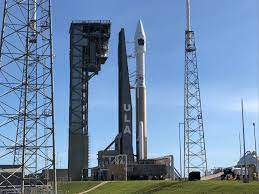Atlas V rocket to launch SBIRS GEO-5 missile warning satellite
 A United Launch Alliance Atlas V rocket carrying the SBIRS Geo-5 missile detection satellite for the U.S. Space Force stands atop Launch Complex 41 at the Cape Canaveral Space Force Station in Florida for a May 17, 2021 launch. (Image credit: United Launch Alliance)
A United Launch Alliance Atlas V rocket carrying the SBIRS Geo-5 missile detection satellite for the U.S. Space Force stands atop Launch Complex 41 at the Cape Canaveral Space Force Station in Florida for a May 17, 2021 launch. (Image credit: United Launch Alliance)The United Launch Alliance will launch an Atlas V rocket carrying a new missile warning satellite for the U.S. Space Force today (May 17) and you can watch it live here. Liftoff is at 1:42 p.m. EDT (1742 GMT).
The Atlas V will launch the Space Based Infrared System Geosynchronous Earth Orbit 5 satellite (SBIRS GEO Flight 5) into orbit from Launch Complex 41 at the Cape Canaveral Space Force Station in Florida. ULA's launch webcast will begin about 20 minutes before liftoff. You can also watch directly from ULA on YouTube here and get live launch updates here.
From ULA:
Mission
A United Launch Alliance (ULA) Atlas V 421 rocket will launch the Space Based Infrared System Geosynchronous Earth Orbit (SBIRS GEO) Flight 5 mission for the U.S. Space Force’s Space and Missile Systems Center (SMC). Liftoff will occur from Space Launch Complex-41 at Cape Canaveral Space Force Station, Florida. Following liftoff, the Atlas V rocket will deliver the fifth SBIRS satellite to a geosynchronous transfer orbit. The mission also includes two multimanifest satellite vehicles.
SBIRS GEO-5 consists of a network of GEO satellites and HEO payloads that provide persistent, infrared surveillance – as well as a sophisticated ground control system that manages that data – to support missile warning, missile defense, battlespace awareness and technical intelligence. Equipped with scanning and staring infrared sensors, the SBIRS spacecraft continue to serve as the tip of the spear for global missile warning as ballistic missile threats proliferate around the world.
SBIRS GEO-5, the fifth SBIRS spacecraft built by Lockheed Martin, but the first military space satellite built on the company’s modernized LM 2100 Combat Bus – an enhanced space vehicle that provides even greater resiliency and cyber-hardening against growing threats, as well as improved spacecraft power, propulsion and electronics.
SMC’s Multi Manifest Office, in partnership with the United States Air Force Academy, will be flying the EZ-3 and -4 flight systems on the SBIRS GEO-5 mission. This multi-manifest mission will support the deployment of two 12U Multi-Manifest Satellite Vehicles, TDO-3 and -4, prior to the deployment of the SBIRS GEO-5 satellite. A multi-manifest mission set allows more capability to be placed on orbit, ultimately providing more critical capabilities to the warfighter.
Launch Vehicle
Payload Fairing (PLF)
The SBIRS satellite is encapsulated in the 13.7-ft (4-m) diameter extra extended payload fairing (XEPF). The XEPF is a bisector (twopiece shell) fairing consisting of aluminum skin/ stringer construction with vertical split-line longerons. The vehicle’s height with the XEPF is approximately 194 ft (59.1 m).
Centaur
The Centaur second stage is 10 ft (3 m) in diameter and 41.5 ft (12.6 m) long. Its propellant tanks are constructed of pressure-stabilized, corrosion resistant stainless steel. Centaur is a liquid hydrogen/liquid oxygen- (cryogenic-) fueled vehicle. It uses a single RL10C-1-1 engine producing 23,825 lb (106 kilo-Newtons) of thrust. The cryogenic tanks are insulated with a combination of helium-purged insulation blankets, radiation shields, and spray-on foam insulation (SOFI). The Centaur forward adapter (CFA) provides the structural mountings for the fault-tolerant avionics system and the structural and electronic interfaces with the spacecraft.
Booster
The Atlas V booster is 12.5 ft (3.81 m) in diameter and 106.5 ft (32.5 m) long. The booster’s tanks are structurally stable and constructed of isogrid aluminum barrels, spun-formed aluminum domes and intertank skirts. Atlas booster propulsion is provided by the RD-180 engine system (a single engine with two thrust chambers). The RD-180 burns RP-1 (Rocket Propellant-1 or highly purified kerosene) and liquid oxygen, and delivers 860,200 lb (3.83 mega-Newtons) of thrust at sea level. Two solid rocket boosters (SRBs) generate the additional power required at liftoff, each providing 348,500 lb (158,076 kg) of thrust. The Atlas V booster is controlled by the Centaur avionics system which provides guidance, flight control and vehicle sequencing functions during the booster and Centaur phases of flight.
Source: https://www.space.com/17933-nasa-television-webcasts-live-space-tv.html
















